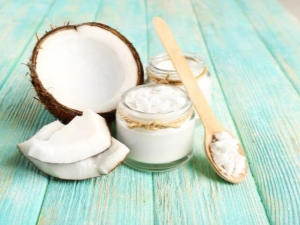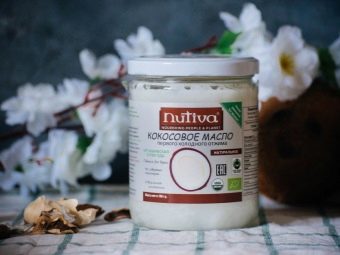Properties and features of using coconut oil for frying

Coconut oil is produced in countries where this wonderful nut grows: in India, Asia, on the African continent. In its structure, it resembles a creamy, but if the temperature of the medium is above 25 degrees, the dense mass becomes liquid.
Description
Oil became popular after scientists discovered a lot of useful properties in it and found out that they do not disappear even in the process of frying. This product is obtained by cold pressing or digestion.
Cold Spin (Virgin)
Cold-pressed oil is made from copra (dried coconut pulp) using a press without heating. The yield of the finished product is small, and therefore it is expensive. But if they talk about the benefits of oil, they mean cold spinning. It has a rich coconut taste and smell, as well as a maximum of nutrients.
Hot spin
The coconut pulp is pressed by hot pressing in a centrifuge, essentially cooked. Some of the useful properties of the heat is destroyed. But the oil prepared in this way turns out many times more, it is cheaper and more common. Taste, smell, aroma of coconut is weakly expressed in the product. Often used in cosmetology.
Roasting method
According to Thai technology, dried pulp is fried, the selected oil passes through special filters. Unfortunately, when using a similar method, the product loses all the beneficial properties, taste and smell, it is useless to use it in food or in cosmetology.
The oil produced can be refined and unrefined.It all depends on the degree of purification.
Unrefined
The oil is minimally cleaned and retains all its beneficial qualities, as well as the taste and smell of coconut. But to heat it above 170 degrees is not recommended, it will give the opportunity to save all the valuable things in it. Cold-pressed unrefined product is considered the most useful for human consumption.
Refined
This oil is purified to the maximum, it loses its taste, smell and beneficial properties. But it can be fried, heating up to 360 degrees, it is an alternative to margarine. Such a product is used in cases when roasting over high heat is required, or when the aroma of coconut does not want to kill the smell of a cooked dish.
Benefit and harm
Composition
The amazing properties of coconut oil have been appreciated not only in the food sector, but also in cosmetology and medicine. It is ninety-five percent fatty acid:
- polyunsaturated include Omega 3 and Omega 6;
- monounsaturated fats are nervonic, oleic, palmitoleic acid;
- saturated fats combine lauric, capric, steoric acid.
Lauric acid makes up fifty-five percent coconut oil. In humans, it is transformed into monolaurin, which is also found in breast milk and is a strong antioxidant.
Benefit
Each fatty acid contained in a coconut is beneficial to the human body. These elements saturate it with energy, with their help hormones are synthesized, immunity is strengthened. Non-fatty acids stimulate bile formation and help self-purification of the liver. Activating metabolism, metabolic processes, this product helps to fight excess weight. Normalizing cholesterol, lauric acid has a positive effect on the cardiovascular system, lowers blood pressure.
Coconut oil is recommended for people with diabetes, as it has a positive effect on the endocrine system. Vitamin D and calcium have a beneficial effect on tooth enamel and bone tissue. Coconut oil is an invaluable product in cosmetology. It is taken orally, make cosmetic masks from wrinkles, stimulate hair growth, with its help they fight cellulite.
Contraindications
The above are not all the properties inherent in coconut oil.They are much more, but, like any useful product, there are also contraindications: it is an individual intolerance and an allergic reaction to coconut constituents, as well as a high caloric content - 860 kcal per 100 g of oil (140 tablespoons per tablespoon).
Subtleties of use
Coconut oil has high point of smoke:
- unrefined - 150-170 degrees;
- refined - 360 degrees.
Such indicators exist due to the large amount of saturated fatty acids. Let's try to figure out what the "point of smoke" means. The coconut product consists almost entirely of saturated fatty acids and almost repeats the composition of animal fat. Only a few percent have polyunsaturated fats (Omega 3, 9), which, at a temperature of 110 degrees, begin to decompose into ketones and aldehydes, in other words, from nutrients they are converted into toxic isomers (carcinogens).
The “smoke point” is the temperature edge that triggers toxic processes, while the product turns black and begins to smoke. Each oil has its own point of smoke. A product with a higher amount of polyunsaturated fat breakdown period is very low. For this reason, it is not recommended to fry food on unrefined cedar, linseed and hemp oil; in the process of heating, it begins to resemble drying oil.
As for coconut oil, to fry food over low heat, you can even use an unrefined product and it is perfectly safe to use purified. If there is a need to fry over high heat, refined cold pressed oil is best. It has a rather high smoking point, and the gentle cold extraction made it possible to retain its beneficial properties.
Reviews
After reading a large number of reviews, we can conclude that the oil is extremely useful, but expensive, so people rarely fry it. Acquired for cosmetic purposes, strengthen hair. Having tasted the subtle original taste and smell of “paradise islands”, they use fresh product with coffee, cereal, dumplings. Who tried to fry in butter, they say about its economy, pancakes turn out completely low-fat.
Negative reviews were associated with the rejection of some people coconut smell, but, using oil as a useful product, after a while it became addictive and acceptable to the unusual flavor. Reading the reviews, you understand that people use coconut oil for other purposes, it is difficult to find a more suitable product for frying. And for eating with salads suitable oil with a high content of polyunsaturated acids.
How to use coconut oil for frying, see the following video.

























